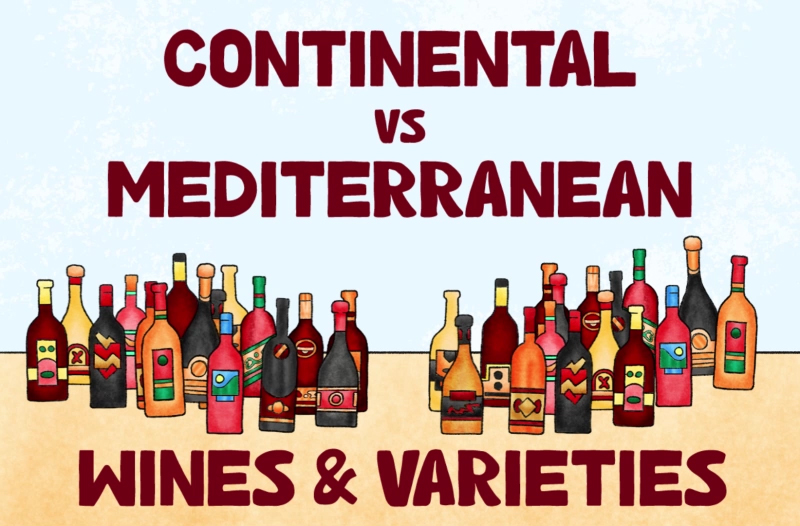The Ultimate Guide to Croatian Rosé Wines

Rosé is the wine that has seen insane growth in sales globally over the past decade. It took Croatian producers a while to catch on to that trend, but nowadays, wine lovers can find plenty of exciting, top-quality rosé wines! The Croatian wine scene has undergone a revolution in rosé wine production over the past decade and given us a reason to experience and look at the world through – rose-tinted glasses! There has been a growing number of high-quality Croatian rosé wines, and the list expands yearly.
Rosé from Istria wine region
In Istria, Teran has proven to be a phenomenal base for rosé. Teran-specific pronounced acidity fit the bill perfectly, piercing refreshments to rosé wines.
Some winemakers use Teran’s natural freshness and fruitiness to make light and easy to drink rosé. Or, if you blend Teran with Cabernet Sauvignon, Merlot, and Syrah, you will get a more complex one like Domaine Koquelicot Koquette and Trapan Rubi Rosé.
Uncover Meneghetti Rosé, a fresh, vivacious, and pleasantly fresh wine made from Merlot and Syrah varieties. They also produce an elegant expression of sparkling rose – Rosé Brut.
Rosé from Dalmatia wine region
There are some amazing rosés in Dalmatia too! However, natural predispositions favor some darker shades of rosé wines.
Plavac Mali is the king of Dalmatia, which means it’s high in tannins and alcohol content level. Nevertheless, a rosé made from Plavac Mali can offer an exquisite experience!
Some of the best examples of rosé wines made from Plavac Mali are:
- Miloš winery’s Stagnum Rosé,
- Saints Hills Heels Rosé, and
- Korta Katarina Rosé from Pelješac peninsula,
- Stina winery’s Opol Rosé and
- Volarević Rosé La Chic! from Komarna,
- Vislander Rosé from island Vis.
Vislander winery from Vis also produces sparkling rosé wine made from Plavac Mali and Kuč native varieties – Vislander Viško Bonda Rosé.
There are other native varieties from which skilled winemakers produce noticeable and well-sought-after Dalmatian rosés. The most prominent variety is Babić.
Notable producers are:
Plavac Mali and Babić achieve deep aromatic qualities and fullness in the context of rosé stereotypes.
We could say that winemakers who produce rosé from Tribidrag (Crljenak, Zinfandel) have a much easier job because its charming fruitiness is more acceptable to the general public.
However, there are places in the heart of Dalmatia where some neglected varieties have been revitalized. One of them is Plastovo.
Plastovo is situated near Šibenik and Skradin, but when it comes to climate, unlike the rest of Dalmatia, there are significant diurnal temperature differences – it snows yearly. Northern winds are responsible for this characteristic continental influence.
That is why Lasina – a variety completely atypical of what we expect from sunny Dalmatia (some even call it the Dalmatian Pinot Noir) – grows successfully in the Plastovo region.
There is also Plavina, a close relative of Plavac Mali–an often overlooked but brilliant variety, especially regarding rosé wines.
Mediterranean aromatic qualities in combination with continental coolness in completely dry and perfectly juicy wines of:
bring to the table some of the best-balanced rosé wines in Croatia. But, as it usually happens, the supply is limited.
Rosé from Slavonia and Danube wine region
The wines are not so limited in the continental part. Many wineries produce rosé wines from Blaufränkisch, Cabernet Sauvignon, Merlot, Pinot Noir, and Zweigelt in the Slavonia and Danube region.
Several of this year’s awarded Croatian rosé wines originate from this particular region.
Notable examples are:
Rosé from the Croatian Uplands wine region
Some sub-regions in this hilly wine region are famous for their sparkling (notably Plešivica) and orange wines. These sparkling rosé wines are among the best in the country:
Rose wine lovers should definitely taste:
- Bolfan Rosé from Zagorje, and
- Lagena Iconic Rosé from the Moslavina sub-region.
What does rosé wine taste like?
Depending on the specific grape varietals used and the winemaking techniques employed, Rosé wines are known for their fruity flavor profile, including notes of strawberry, citrus, melon, raspberry, cherry, and flowers.
Although rosé wines are typically produced in a lighter style, they still provide diverse flavor profiles and can range from sweet to savory to dry.
When it comes to rosé, the variety of shades is truly remarkable. Ranging from delicate hues of salmon and light peach to vibrant shades of cherry red, there’s no shortage of options. In fact, there are so many different shades that it would be difficult to count them all accurately.
Rosé wine and food pairing
Rosé wines are a delicious drink and perfect for various foods. Some of our recommendations are to serve the lighter ones with appetizers, carpaccio, and fresh shrimp.
And have you heard about Brudet? It’s a traditional fish stew that’s been passed down for generations. What makes it truly special is the variety of fish used and the technique in which it’s cooked. It is best served over polenta (or palenta) and with a full-bodied rosé.
Still, when properly chilled and served, it also functions as refreshment on its own.
Did you know?
In Dalmatia, traditional rosé was called “Opolo” which resembles “pola-pola” (fifty-fifty). Namely, it was obtained by mixing red and white wine, a method that no longer exists. Some bottles proudly bear the name associated with this heritage, but the method is not the same.
Rather than drawing lines and limiting ourselves to a specific wine, exploring and choosing the rosé that appeals most to us is best.
Whether you prefer a pale, dry, semi-dry, or bolder, deeply-hued rosé wine, the most important thing is to savor each sip and enjoy the unique flavors and aromas that make this type of wine such a beloved beverage!
Are you ready to embark on a thrilling rosé wine journey? Look no further than our expertly curated selection, handpicked with care by our passionate team.
Or head to our list of Top 10 Croatian rosé wines.



















